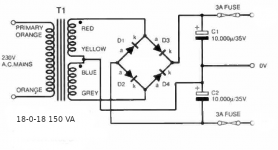I have seen a similar question on SMPS dual rail PS, but my query is related to a dual rail linear PS.
Can I use just the positive rail and leave the negative rail open? The load would be a class A amp.
Thanks
Can I use just the positive rail and leave the negative rail open? The load would be a class A amp.
Thanks
If the supply really generates both rails, not relying on a virtual ground or a rail-splitter, I see no obstacle.
Depending on the topology/construction of the supply, the power output might need to be derated, up to 50% in the worst case
Depending on the topology/construction of the supply, the power output might need to be derated, up to 50% in the worst case
Yes, post the schematic and maybe it can be rewired to use all the parts.
What DC voltage and DC current do you need?
What DC voltage and DC current do you need?
Toroid transformer - 18-0-18, 150 VA
After rectification, I get +- 27 V DC
After the rectifier caps is a cap multiplier, and its simulated output voltage is around 20 V DC
My class A amp bias is 1.2 A, 7W RMS into a 8 ohm speaker
Can I just use the positive rail for this application?
After rectification, I get +- 27 V DC
After the rectifier caps is a cap multiplier, and its simulated output voltage is around 20 V DC
My class A amp bias is 1.2 A, 7W RMS into a 8 ohm speaker
Can I just use the positive rail for this application?
Attachments
Yes, you can. If you leave diodes D1, D2, and capacitor C2, you'll basically get what has been done in many, many tube rectifier PSU's. But, as Elvee said, you'll not get the xformer's full power capability.
Best regards!
Best regards!
The tests didn't go well. With the amp as a load, the bias current turned out to be 1.9A at 21.4V (after the cap mx).
The toroid transformer did not like it one bit, as it was mechanically humming loudly. I guess I will have to shelve this experiment for now. The transformer seems unsuitable, but what I don't understand is the bias current of the JLH amp. I simulated around 1.2A, but was surprised with 1.9A. The output transistors Hfe matched that in the simulation.
The toroid transformer did not like it one bit, as it was mechanically humming loudly. I guess I will have to shelve this experiment for now. The transformer seems unsuitable, but what I don't understand is the bias current of the JLH amp. I simulated around 1.2A, but was surprised with 1.9A. The output transistors Hfe matched that in the simulation.
The sensible thing to do first would be to turn down the bias to its design value, so you don't overload the supply.
Jan
Jan
1.9A is no problem for your transformer, even with the 0.707 derating factor.The tests didn't go well. With the amp as a load, the bias current turned out to be 1.9A at 21.4V (after the cap mx).
The toroid transformer did not like it one bit, as it was mechanically humming loudly. I guess I will have to shelve this experiment for now. The transformer seems unsuitable, but what I don't understand is the bias current of the JLH amp. I simulated around 1.2A, but was surprised with 1.9A. The output transistors Hfe matched that in the simulation.
I think you have somewhat miswired the diodes, resulting in a half-wave rectification, and disastrous effects (it is something toroidals positively hate).
If you wire the rectifier properly, you should be OK
Hi Elvee, it was/is a working PS, using a bridge rectifier. I am now using the same dual rail PS for a class AB amp, and it is functioning well.
During my test, I inserted a series dim bulb tester, and thus was able to get the voltage down to 14.15V after the cap mx, with the resulting bias current measuring 1.15A. The toroid was silent and performed adequately. BTW, the cap mx drops 3.1V.
It's a different topic as to why the simulated bias current does not agree with reality.
During my test, I inserted a series dim bulb tester, and thus was able to get the voltage down to 14.15V after the cap mx, with the resulting bias current measuring 1.15A. The toroid was silent and performed adequately. BTW, the cap mx drops 3.1V.
It's a different topic as to why the simulated bias current does not agree with reality.
- Home
- Amplifiers
- Power Supplies
- Single rail use from a dual rail linear PS
